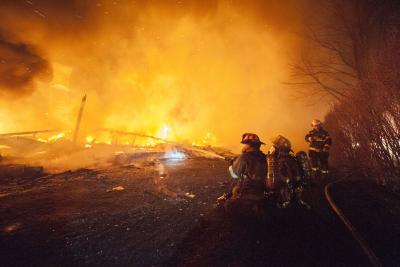PSEG Upgrade Stalled
PSEG Upgrade Stalled
East Hampton Town’s stop-work order against PSEG Long Island, the utility whose transmission line upgrade has prompted a public outcry here, was upheld on Monday in State Supreme Court, Riverhead. Acting State Supreme Court Justice Ralph Gazzillo denied PSEG’s request for a temporary restraining order that would have allowed it to continue work at the substation.
Construction at an Old Stone Highway, Amagansett, power substation will therefore remain stalled, although the utility’s request for a preliminary injunction to prevent the town from further interference is yet to be decided.
Meanwhile, Long Island Businesses for Responsible Energy, a new group formed to fight PSEG’s installation of high-voltage wires and large poles along town and village residential streets, has hired lawyers and plans an April 26 meeting in order to gather plaintiffs to sue PSEG.
The stop-work order was posted at the Amagansett site on April 4 after Tom Preiato, the town building inspector, found clearing, fencing, and the construction of a building, all of it done without a town building permit or site plan approval. PSEG argued that it was exempt from those requirements.
The installation of new utility poles along a six-mile route from a substation on Buell Lane in East Hampton Village to Amagansett has been completed, and wires carrying 23 and 33 kilovolts are being installed by crews along the line.
Members of Save East Hampton: Safe Responsible Energy, who mobilized soon after PSEG began work, and the new business group, which split off from the original grassroots group, have raised concerns over aesthetics, safety, the potential health effects of living under high-tension wires, and the effect of their proximity on property values. They have called for the six miles of line to be buried.
Although PSEG officials attended a March 5 meeting at East Hampton Town Hall for preliminary talks about burying the lines, they have subsequently refused to discuss the possibility unless East Hampton taxpayers foot the entire bill.
Local and state officials proposed a cost-sharing scenario, similar to one used in Southampton Town, where residents here would be assessed for the additional cost of burying the lines versus installing them above-ground, but PSEG rejected it.
Meanwhile, the utility has continued work on the overhead line project, which PSEG insists is critical to maintaining the power supply here through the summer.
In a press release this week, Long Island Businesses for Responsible Energy, a nonprofit corporation co-chaired by Helene Forst and Rebecca Singer, said that “we believe that PSEG has fabricated the idea that we are in need of additional energy to get us through the summer of 2014. It should be noted that we had no brown-outs during the summer of 2013 despite the fact that LIPA willingly dismantled three generators in May 2013 that supplied back-up powerto 4,000 households, undercutting PSEG’s dire-consequences argument for the summer of 2014. And that there are preferred alternatives for meeting the power needs of the East End.” Under a state-approved agreement the Long Island Power Authority handed oversight of the Long Island power supply to PSEG Long Island, a New Jersey company subsidiary, at the start of 2013.
“PSEG wants the ratepayers to bury the lines once they’ve completed the overhead project. This will increase their profits once again,” the business group said in the release. “After they’ve irreparably damaged our environment, depreciated our property values, butchered and killed our trees, damaged our aesthetics, polluted our groundwater and soil, and exposed us to numerous health risks associated with continuous exposure to high-tension wires, their profits will go back to New Jersey, instead of being reinvested on Long Island.”
Ms. Singer said Monday that the group had engaged Irving Like of the Babylon law firm Reilly Like & Tenety, and Leon Friedman, a professor of civil liberties at Hofstra Law School.
As a special counsel to Suffolk County on environmental, nuclear power, offshore oil, and utility rate and energy matters, Mr. Like was involved in the successful effort to keep the Long Island Lighting Company from operating nuclear power plants in Shoreham and Jamesport. He is a former member of the LIPA board.
Mr. Friedman, who specializes in civil, First Amendment, and intellectual property rights, was a staff attorney for the American Civil Liberties Union. He was the lawyer, depicted in the film “The Hurricane,” who got Rubin (Hurricane) Carter’s conviction for murder in New Jersey overturned.
Ms. Singer said a door-to-door effort will be made to contact all residents along the six-mile transmission path to invite them to join her, Ms. Forst, and her husband, Jack Forst, in a plaintiffs’ group.
The attorneys will argue, she said, that the plaintiffs’ properties have been negatively affected by the PSEG project, through property devaluation or health, safety, environmental, or aesthetic concerns. Property assessments will be compiled by a professional assessor, at no cost, to reflect their values before and after the installation of the poles and lines.
“The damages . . . should far out-total the cost of PSEG burying the lines,” Ms. Singer said. In addition to helping to establish damages, she wrote in an email, “this will also set up the possibility for a reassessment of our properties for tax purposes, which has negative consequences for the town and village.”
Save East Hampton held a fund-raiser at Babette’s restaurant on Sunday. Richard Janis, a co-chair of the group with Terri Rauch, said it is working to support Supervisor Larry Cantwell in his efforts to get state officials, including Gov. Andrew M. Cuomo, to intervene. The group, Mr. Janis said Tuesday, has contacted the chairman of the LIPA board and invited him to come to East Hampton to assess things firsthand, as Audrey Zibelman, the chairwoman of the State Public Service Commission, recently did.
Mr. Janis said the group had asked County Legislator Jay Schneiderman to introduce legislation calling for all high-voltage transmission lines in Suffolk to be buried.
The two citizens’ groups will work together, he said. “We’re both looking for the same end result. Everyone’s looking for the same goal. The more voices out there, the better.”
He noted that communities in Port Washington and North Hempstead are also fighting with PSEG over the installation of high-voltage wires on tall poles.








